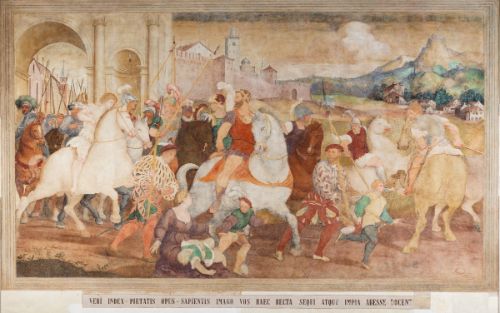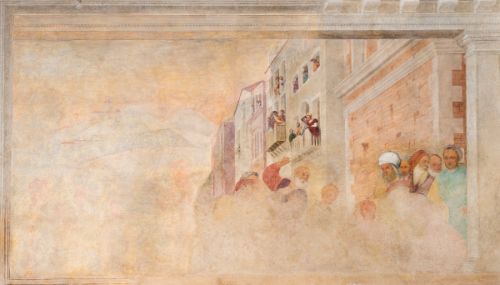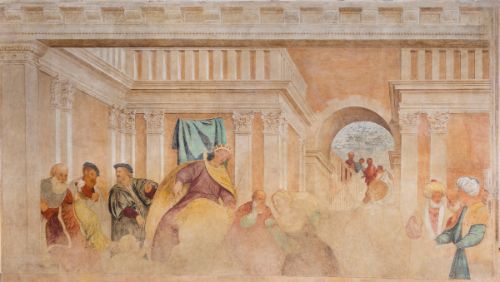The Loggia
Under the elegant open gallery, the building that accommodates the Museo della Battaglia has preserved three fresco panels, painted within the first three decades of the sixteenth century upon completion of the construction works at the Palace. Unfortunately they are now partially damaged and incomplete. As is the norm in public buildings where justice was administered, they depict legendary episodes of "exemplary judgements", passages from the Bible and Roman history related precisely to the themes of justice and mercy, admonishment and allegory of good government.
The frescoes are painted by the Friulian artist Pomponio Amalteo (Motta di Livenza, 1505 - San Vito al Tagliamento, 1588), son-in-law of the famous Antonio de Sacchis, known as "Il Pordenone" (Pordenone, 1484 - Ferrara, 1539), to whom the sketches from which Amalteo extracted the scenes are attributed.
The judgement of Trajan
Emperor Trajan is depicted on horseback while, followed by a large group of riders, he emerges from a fortified city that has a pleasant mountainous landscape in the background. Here he stops at a woman whose son was killed and, having identified the culprit, instructs him to come closer and hands him over to the woman, who had remained childless.
Latin Inscription
VERI INDEX - PIETATIS OPUS - SAPIENTIS IMAGO VOS HAEC RECTA SEQUI ATQUE IMPIA ABESSE DOCENT
Sign of truth - work of mercy, image of wisdom: these things (which you see in the picture) teach how to do things right and stay away from those ungodly people
The judgement of Daniel
Young Daniel is depicted addressing the judges and elders of the community in defence of the chaste Susanna who, unjustly defamed, was sentenced to death. Surrounded by the crowd, the girl looks towards the sky, while several people from neighbouring buildings witness the scene.
The judgement of Solomon
Against the backdrop of an elaborate architectural setting, crammed with many people, Solomon, seated on a throne, is preparing to pass judgement about the child caught in a dispute between two women. His real mother is to be identified as the one willing to surrender her son, provided that he would not be cut in half as the king had provocatively ordered to do.








